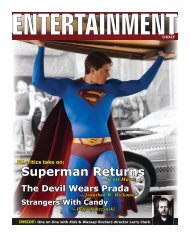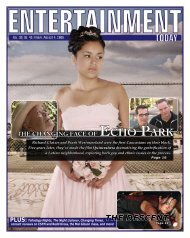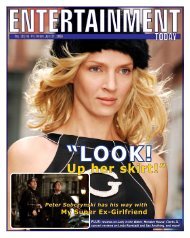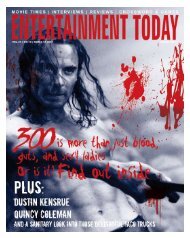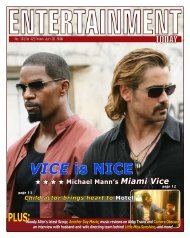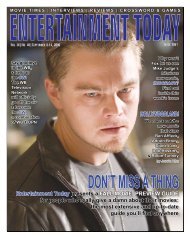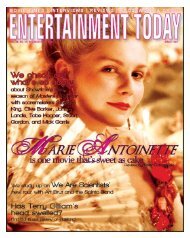LOVE
this issue of Entertainment Today
this issue of Entertainment Today
Create successful ePaper yourself
Turn your PDF publications into a flip-book with our unique Google optimized e-Paper software.
Courtesy of Columbia Pictures<br />
The Rock coaches a group of misfit youngsters in the true-life story of the power of football.<br />
GRIDIRON GANG<br />
(3 out of 4 stars)<br />
Directed by Phil Joanou<br />
Starring: Dwayne “The Rock”<br />
Johnson, Xzibit, L. Scott Caldwell,<br />
Leon Rippy, Kevin Dunn<br />
120 minutes, Rated PG-13<br />
by Josh Hickman<br />
Based on a true story, Gridiron<br />
Gang is about a group of juvenile<br />
delinquent losers from one of the<br />
worst neighborhoods in the United<br />
States. Through football, they are<br />
given the chance to become winners.<br />
The story is inspiring, even<br />
though the results of the actual<br />
football program weren’t absolute.<br />
Nonetheless, there was a level of<br />
success in real life that makes for<br />
fine storytelling. And, truly, any<br />
success was better than the life that<br />
fate dealt these beleaguered boys.<br />
The big question for moviegoers<br />
is how the Rock performs as a serious<br />
actor. While I can understand<br />
their doubt, the critics fail to see<br />
that this is the path that an ex-wrestler<br />
must take to gain the respect<br />
he deserves as an<br />
actor. Every now<br />
and then, an actor<br />
rises from a comical<br />
or untraditional<br />
genre. Gridiron<br />
Gang is the first<br />
step toward the title<br />
of “serious actor”<br />
for Dwayne “The<br />
Rock” Johnson.<br />
Courtesy of Columbia Pictures<br />
The story kicks<br />
off with a boy<br />
named Roger Weathers (Michael J.<br />
Pagan). Roger is put in his juvenile<br />
detention center’s twisted version<br />
of solitary. Enter Sean Porter<br />
( Johnson) who wakes the inmate<br />
the way he woke another juvenile<br />
earlier that night: by smacking him<br />
on the head. Porter yells at him<br />
and reads him the riot act. After<br />
some resistance, Roger begins to<br />
Dwayne “The Rock” Johnson as Porter.<br />
cry. Porter asks him one question:<br />
“Where will you be in three<br />
years. Tell me, where will you be<br />
when you’re 21?!” Roger answers,<br />
“In prison.” Porter yells, “Wrong,<br />
you’ll be dead.” Thus establishes the<br />
movie’s raw tone. Gridiron Gang is<br />
no Mighty Ducks.<br />
The PG-13 rating is pushed to<br />
the edge in this film with violence<br />
and repeated vulgar language. One<br />
shouldn’t forget, however, that this<br />
is the real life to which the boys in<br />
the film have grown accustomed.<br />
The violence and the language,<br />
while perhaps not necessarily meant<br />
for the ears of impressionable<br />
young viewers believing they’re<br />
about to see another Disney-made<br />
inspirational sports movie, are thus<br />
appropriate.<br />
There is a disturbing drive-by<br />
shooting where the before-mentioned<br />
Roger is, in fact, killed.<br />
Prior to the end of this movie, more<br />
people will die. Some will be shot,<br />
and others will find a way out. The<br />
violence seems misplaced in such<br />
a movie, but considering the place<br />
where these boys come from, it is<br />
nevertheless necessary to convey the<br />
film’s reality.<br />
For the sports<br />
fan, there’s plenty<br />
of football in the<br />
film. You follow<br />
the team f rom<br />
the first practice<br />
to their final victory<br />
in the playoffs.<br />
The football<br />
is realistic, and as<br />
a young football<br />
player myself, the<br />
visuals brought back fond memories.<br />
This movie restored my faith in<br />
the gridiron. It reminded me that,<br />
where the game might not have<br />
been the best fit for me, it was and<br />
is for these boys.<br />
Stay after the movie to watch<br />
the documentary footage of the<br />
real team alongside Sean Porter. P<br />
THE BLACK DAHLIA<br />
(4 out of 4 stars)<br />
Directed by Brian De Palma<br />
Starring: Josh Hartnett,<br />
Aaron Eckhart, Scarlett Johansson,<br />
Mia Kirshner, Hilary Swank<br />
121 minutes, Rated R<br />
by Peter Sobczynski<br />
When I first heard the news<br />
that The Black Dahlia, James Ellroy’s<br />
1987 best-seller inspired by the<br />
1947 murder that— due to the sheer<br />
brutality of the crime and the fact<br />
that it still remains unsolved—lives<br />
on in the collective memory to this<br />
day, was going to be brought to the<br />
screen by Brian De Palma, I have to<br />
admit to some mixed feelings about<br />
the project.<br />
On the one hand, De Palma—to<br />
my mind—remains one of the most<br />
striking and dynamic American filmmakers<br />
working today, and the idea of<br />
his tackling a book chock-full of the<br />
very elements that have driven many<br />
of his best films (voyeurism, lurid<br />
sexuality, and morally ambiguous<br />
characters driven<br />
to distraction by<br />
their obsessions),<br />
sounded like a<br />
match made in<br />
heaven. On the<br />
other hand, De<br />
Palma, as even<br />
his detractors will<br />
admit, is primarily<br />
a visual stylist<br />
whose best films<br />
are symphonies of<br />
sound and visions<br />
intricately pieced<br />
together with<br />
clockwork precision…while<br />
Ellroy<br />
is one of those<br />
writers whose<br />
genius lies not in<br />
his narrative structure (though that<br />
aspect is not to be ignored) but in the<br />
way that he uses his voice as a writer<br />
to conjure up meticulously detailed<br />
characters and environments with<br />
nothing more than a few well-chosen<br />
words.<br />
Capturing the voice of a distinctive<br />
writer in cinematic terms is a<br />
difficult chore for even the most<br />
skilled filmmaker, and the last time<br />
that De Palma tried it himself, the<br />
result was The Bonfire of the Vanities,<br />
a film that isn’t quite as bad as its<br />
reputation suggests, but one that<br />
certainly never came close to capturing<br />
what Tom Wolfe put on the page<br />
of his book. Luckily for all involved,<br />
the pairing of De Palma and Ellroy<br />
ENTERTAINMENT TODAY SEPTEMBER 15-21, 2006 |24|<br />
Courtesy of Universal Pictures<br />
turns out to have been a far more<br />
fruitful endeavor, and the resulting<br />
film is a real knockout: a great-looking<br />
neo-noir gem that shows off the<br />
artists’ respective talents in ways that<br />
will surely dazzle even the most jaded<br />
of viewers.<br />
Josh Hartnett and Aaron Eckhart<br />
star as Dwight “Bucky” Bleichert and<br />
Lee Blanchard, a pair of LA cops<br />
who meet while trying to restore<br />
order during a riot, and who bond<br />
when they are thrown together in<br />
a charity boxing match that has<br />
been cynically designed to promote<br />
goodwill just before a bond issue<br />
involving pay raises goes before the<br />
public. The bond passes, and Bucky<br />
and Lee—the new glamour boys of<br />
the department—are transferred from<br />
warrants to homicide.<br />
After hours, they form an oddly<br />
amicable trio with Kay (Scarlett<br />
Johansson), a small-town girl who<br />
Lee saved from a bad situation and<br />
made his girlfriend. Some viewers<br />
may question the relevance of this<br />
section of the film that takes up<br />
roughly the first 30 minutes, and<br />
look at it as little more than Jules &<br />
A surprisingly ravishing Hilary Swank with Josh Hartnett in The Black Dahlia.<br />
Jim with fedoras. It does seem odd at<br />
first, but De Palma and screenwriter<br />
Josh Friedman (War of the Worlds)<br />
quietly and effectively lay down a lot<br />
of character-related material that will<br />
later pay off in spades.<br />
While cleaning up after a stakeout<br />
that ends in a hail of gunfire and<br />
several dead bodies, Bucky and Lee<br />
become aware of another, bigger<br />
crime scene just across the way: the<br />
discovery of the bisected nude body of<br />
a young woman who has been drained<br />
of all her blood and major internal<br />
organs, and had her mouth slit from<br />
ear to ear into a hideous grin.<br />
Bucky looks at it as just another<br />
dead girl, and wants to get back to<br />
more pressing concerns such as a<br />
known rapist/killer thought to be<br />
on the prowl. But, something about<br />
the sight of the woman—revealed to<br />
be party girl/failed actress Elizabeth<br />
Short (Mia Kirshner)—throws a<br />
switch in Lee, and he gets his duo<br />
assigned to the case. Before long,<br />
Lee becomes obsessed with the case<br />
to such a degree that it begins to<br />
frighten both Kay and Bucky. On<br />
his end, Bucky pursues leads that<br />
take him on a convoluted journey<br />
through the lesbian underground of<br />
mid-1940’s Los Angeles as he creeps<br />
closer to Madeline Linscott (Hilary<br />
Swank), the rich daughter of a corrupt<br />
businessman who bears more than<br />
a passing resemblance to Elizabeth<br />
with whom she may or may not have<br />
had some past associations.<br />
In recent years, many filmmakers<br />
have offered their own takes on film<br />
noir, the most notable being LA Confidential,<br />
Curtis Hanson’s 1997 adaptation<br />
of another James Ellroy book.<br />
In The Black Dahlia, De Palma offers<br />
a unique approach to the genre that<br />
sets it apart from these films. Instead<br />
of giving the material a realistic feel<br />
of the kind seen in the LA Confidential’s<br />
or Chinatown’s<br />
of the world, De<br />
Palma instead offers<br />
a frankly stylized<br />
vision that goes to<br />
great lengths to recreate<br />
the look and<br />
feel of the old classics<br />
to such a degree<br />
that it feels less like<br />
an homage to the<br />
genre and more<br />
like an authentic<br />
apotheosis.<br />
(The only drawback<br />
is that while<br />
the film has been<br />
gorgeously shot by<br />
longtime De Palma<br />
collaborator Vilmos<br />
Zsigmond, it has been shot in color,<br />
even though it is a story that fairly<br />
screams out to be told in black-andwhite.)<br />
Beyond simply working<br />
as a thing of ravishing beauty, this<br />
approach allows the scenes in which<br />
we are allowed to see and hear the<br />
things that could only be hinted<br />
at in the days of the Production<br />
Code (a bloody tooth landing on a<br />
scorecard during a boxing match and<br />
the exact details of a stag film that<br />
Elizabeth shot become key clues).<br />
They therefore have more of an<br />
immediate impact than they might<br />
have otherwise elicited.<br />
At the same time, De Palma<br />
see DAHLIA on p.27



